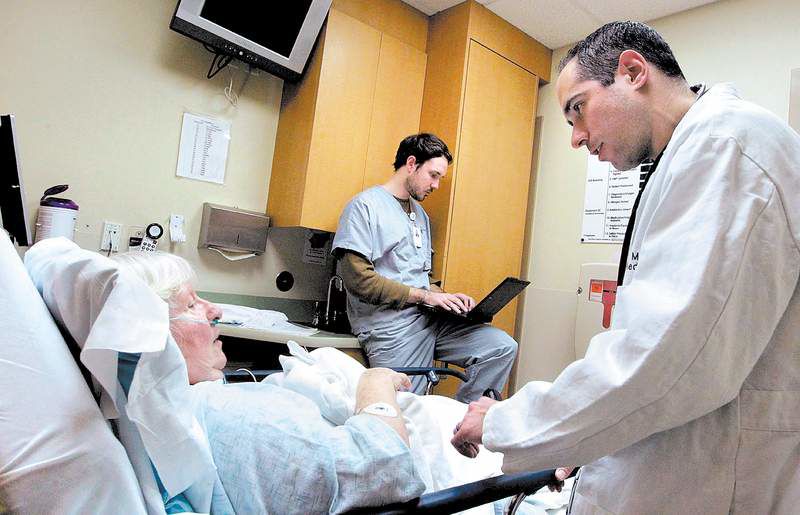Scribes find their place helping doctors in the ER
Published 5:00 am Thursday, March 17, 2011

- Robert Peters, left, takes detailed notes as Dr. Brian Lebo, right, talks with emergency room patient Charlene Stratton at SSM DePaul Health Center in Bridgeton, Mo., in January.
ST. LOUIS — As hospitals switch to electronic medical records, doctors worry about spending more time in front of computers rather than patients. To solve the problem, physicians are turning to an age-old profession — scribes.
The emergency department at DePaul Health Center in Bridgeton, Mo., which sees about 60,000 patients a year, is the first to use scribes in the St. Louis area. By February, all the hospital’s emergency physicians will have a scribe tapping away at a laptop or tablet computer while they work. Across the nation, about 200 hospital emergency departments have started using scribes, most within the past two years, according to the three major companies providing scribes.
As Dr. Brian Lebo examined a 71-year-old woman with chest pain and dizziness Monday in the emergency department at DePaul Health Center, scribe Robert Peters stood quietly in the corner typing the woman’s answers as Lebo asked when her pain started, what medications she was taking and gathered her family history. The doctor told the woman what might be wrong and what tests he planned to order.
And the scribe documented it all.
“I can just completely focus on and deal with the patient,” Lebo said.
Driving the increase in using scribes is the push to scrap paper charts for digital, with the aim of improving patient safety. The federal government has set aside about $20 billion for doctors who use electronic records. Eventually, doctors who fail to switch will see their Medicare and Medicaid reimbursement rates cut by 5 percent.
“The escalation in the use of scribes mirrors the use and implementation of electronic medical records,” said Dr. David Strumpf, the CEO of Emergency Medicine Scribe Systems, a California-based company that has seen its contracts with emergency rooms grow to 35 from five over the past two years. “It’s really growing exponentially now.”
In the metro area, SSM Health Care — which operates DePaul Health Center and six other area hospitals — completed the switch to electronic medical records by April 2009. Shortly after that, St. John’s Mercy Medical Center and its sister hospital in Washington, Mo., also made the switch. Other hospitals in the area are in the process of going digital.
Digital records have been shown to improve the access of medical information, making it more thorough, accurate and portable. But entering the data takes more time.
“One of the biggest slowdowns for me is charting and documentation,” said Lebo at DePaul. “It often takes as much or more time than dealing with a patient.”
After the switch to computer records, emergency departments have reported a loss in productivity. At DePaul, patient wait times initially increased 28 percent and patient satisfaction declined 40 percent despite additional staffing, said Dr. Stephen Larson, director of the hospital’s emergency department. St. John’s Mercy also reported a peak in wait times.
While both hospitals have seen wait times drop as doctors get past the learning curve, the emergency physicians group at DePaul decided to begin the scribe program in December “to allow us to continue to add to our gains,” Larson said.
Dr. Steve Hilton, assistant director of the emergency department at St. John’s Mercy, said while emergency physicians have become more comfortable using the record system, hiring scribes “is still on the table for us.”
Scribes are often young and tech-savvy pre-med students looking to gain valuable experience.
Applicants go through a rigorous interview and training process, with tests along the way, said Afsha Rais, a trainer for PhysAssist Scribes in Fort Worth, Texas, which runs the program at DePaul.
The company’s scribes spend 100 hours training in an emergency room under a veteran scribe before going solo, she said. The doctor checks everything the scribe has recorded before making the record accessible.
Larson said, “The patient wins because I get to spend more time with them, and I win because I can spend more cognitive time on my patient rather than finding what box to enter this information in.”
Another person who wins is the scribe. Even though they earn just $8 to $10 an hour, they learn what the job is really like by being attached to the hip of a physician.
“It’s a great opportunity to see how doctors make decisions and how they gather information and come up with treatment,” said Peters, 26, while on his first solo Monday as a scribe at DePaul. The job is also helping prepare him for taking the medical school entrance exam this spring.
He’s leaning toward specializing in emergency medicine, he said.






